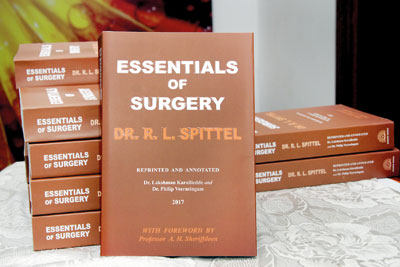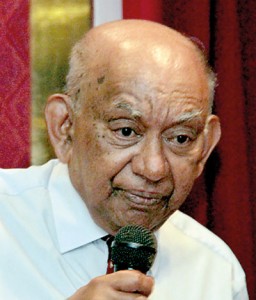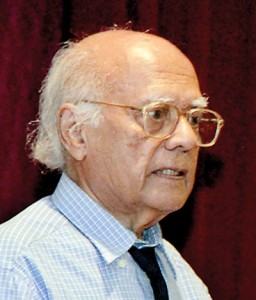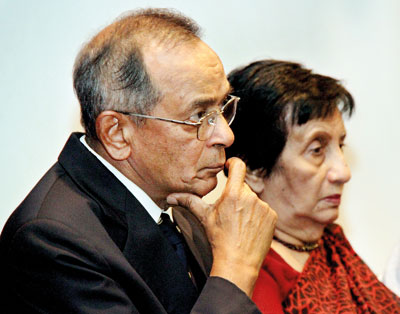Surgery through prose from Spittel

An invaluable book for medical students and surgical trainees. Pix by Indika Handuwala
It was lost awhile but has now been resurrected, with additions that make the timeless and valuable, the invaluable.
Many a stressed medical student who burns the midnight oil or the postgraduate doctor aspiring to be a surgeon struggling beneath a heavy load of ward-work and study will heave a sigh of relief.
For, now they can move away from poring over huge tomes with thousands of pages and pick up a small book by a hands-on practitioner who was a firm believer that ‚Äúif fundamental principles are thoroughly grasped by the student, their application in diagnosis and treatment becomes a habit of the mind, then the subject of surgery becomes both interesting and simple‚ÄĚ.
Aptly it was at the Lionel Memorial Auditorium of the Sri Lanka Medical Association (SLMA) that the ‚ÄėEssentials of Surgery‚Äô by Dr. R.L. Spittel, reprinted and annotated was launched recently amidst a large and distinguished gathering. While the Editors are respected Anaesthetist Dr. Lakshman Karalliedde now based in the United Kingdom and retired Senior Consultant of the National Hospital of Sri Lanka (NHSL), Dr. Philip Veerasingam, many big-names in the medical field are the annotators and the foreword is by an eminent surgeon-teacher Prof. A.H. Sheriffdeen.
Even for a non-medic, a cursory look through the book by Dr. Spittel who wrote it when he was Surgeon of the Colombo General Hospital (NHSL), when there were no niche specialties in surgery but a rounded whole, and Lecturer in Clinical Surgery at the Ceylon Medical College, brings about amazement how simply and logically he has tackled all matters surgical.
Remember, it had first been published by Dr. Spittel back in 1932, when as Prof. Sheriffdeen points out it was ‚Äúthe pre-antibiotic era, viruses and genetics were unknown, when anaesthesia was in its infancy and the only imaging investigation available was X-rays‚ÄĚ.
Dr. Spittel, of course, had only a very simple intention‚Ķ‚Ķ..‚Äúto inculcate the general principles of surgery and to present in a concise form the instructions contained in larger standard textbooks‚ÄĚ.
Believed to be the first book on surgery written by ‚Äėapi venuwen api‚Äô, by a Sri Lankan for Sri Lankan students, Dr. Spittel in his own way hoped to clear the surgical pathway and create enlightenment ‚Äúas bulky textbooks take so long to get through‚Ķ..and the student is apt to forget one part while he studies another‚ÄĚ.

Dr. Lakshman Karalliedde
With surgical precision, Dr. Spittel has dealt with wide and varied, minor and major challenges a surgeon will face. From the ‚ÄėNature of the Disease‚Äô which includes a crystal clear picture of bacteria, even their different shapes, that cause disease to Sterilization & Disinfection to Gangrene to Tumours & Cysts to Fractures to Deformities to the Nervous System to the Larynx, Trachea & Bronchi, with much more in-between.
The sketches of varieties of spina bifida, deformities of the knee-joint, arterio-venous aneurysms and photographs such as claw hand due to leprotic infiltration of the ulnar nerve or rhinophyma to name a few enhance the book because they will remain forever etched in the memory of the reader.
Septicaemia gets this graphic imagery‚Ķ‚Ķ.‚ÄúA surgeon, while making multiple incisions in a case of spreading cellulitis of the leg, infected an unobserved ‚Äėhang nail‚Äô. Eighteen hours later, he woke with excruciating pain in the inner side of the arm; a small spot on the thumb close to the edge of the nail was red and tender, and was the only indication as to the site of the infection‚Ķ‚Ķ‚Ķ.The arm soon became swollen and very painful and the skin patchy and streaky from infection of the superficial lymphatics. Under treatment the condition improved and the patient left hospital in a week.
‚ÄúHe was, however, indiscreet enough to use his arm too soon and the infection flared up again. The result was that towards the end of the second week, he felt worse, lost his appetite, the pain and swelling in the arm became intense, and fever set in. An incision was made in the arm; it was found to be infiltrated, but without definite evidence of pus. The next day he was utterly prostrated and felt very ill indeed. He begged that his arm be ‚Äėcut to tatters as it was bursting with pain‚Äô. Numerous incisions were made, injections of antistreptococcal serum were given, and antiseptic compresses and baths administered.
‚ÄúFor the next four days he hung between life and death, he was in a semi-conscious state‚Ķ‚Ķ‚Ķ‚Ķ‚ĶThe next phase was one of utter helplessness and great suffering for a period of four months. During this time he emaciated to a skeleton, abscesses formed in various parts of the arm and had to be opened and drained under anaesthesia no less than a dozen times; the shoulder joint was infected, the supraclavicular glands became swollen and tender: the temperature remained high for the greater part of three months only occasionally coming down to normal. Then followed four months of tardy convalescence, the patient eventually recovering with an ankylosed shoulder joint.‚ÄĚ
Such descriptive detail brings the disease to anyone’s side and he has been able to achieve such imagery because in this instance, Dr. Spittel was not just a surgeon but also the patient.
Prof. Sheriffdeen picks up ‚Äúfundamental principles‚ÄĚ by pointing out that Dr. Spittel has reiterated that gauze should never be pushed into discharging wounds and sinuses for it is the most effective way of preventing pus from escaping. However, Prof. Sheriffdeen explains that even now plugging the wound is a common practice and many patients have suffered septicaemia, sometimes ending in amputation and even death.
Going down a non-surgical pathway, onto his ‚Äúliterary‚ÄĚ mind and the romanticism of writers of fiction, Prof. Sheriffdeen recalls how as a young boy he read Dr. Spittel‚Äôs novel ‚ÄėWhere the White Sambhur Roams‚Äô and how a critic had said that the author had ‚Äúout-tarzaned‚ÄĚ Tarzan!

Dr. Philip Veerasingam
Looking at Dr. Spittel‚Äôs multifaceted persona, he says, ‚ÄúApart from surgery, Dr. Spittel also wrote fiction and on the fauna and flora of Ceylon. He had an intimacy with the Veddahs, with the Veddah Chief attending his funeral to chant devotional songs. He also had a flair for painting and music.‚ÄĚ
In surgery too, his licence in using words such as ‚Äúacuter‚ÄĚ, ‚Äúcommoner‚ÄĚ and ‚Äúsapremia‚ÄĚ and the description of ‚Äúa patient violently intoxicated with bacterial pus‚ÄĚ, puts him on a different plane from the usual writers.
Dr. Wilfred Jayasuriya, meanwhile, delved deeper into the literary aspects of the book.
Therefore, ‚ÄėEssentials of Surgery‚Äô within its covers enfolds both a work of science and a work of art. This is why it needs to be on the easily accessible shelf not only of students of surgery but anyone, for all and sundry are prone to disease which require surgery and these diseases are artfully described by Dr. Spittel.
As Prof. Sheriffdeen endorses: ‚ÄúIt truly is a collector‚Äôs item.‚ÄĚ

Dr. Wilfred Jayasuriya

Prof. A.H. Sheriffdeen and Dr. Premini Amerasinghe at the launch of the book
(‚ÄėEssentials of Surgery ‚Äď Reprinted & Annonated 2017‚Äô priced at Rs. 1,950 is available at all leading bookshops and Sooriya Publishers, 109, Ven. S. Mahinda Mawatha, Colombo 10.)


